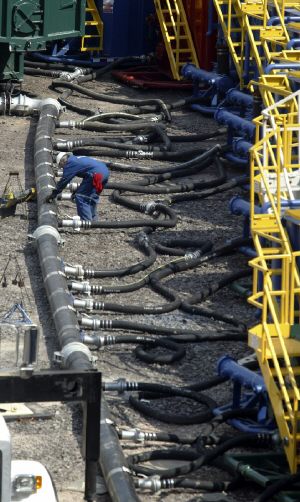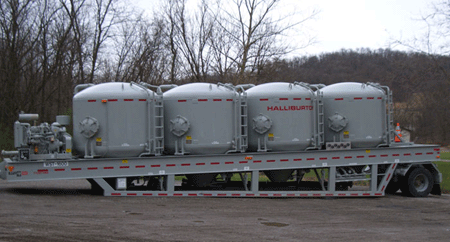Hydro-fracturing
From Wikimarcellus
| Revision as of 01:57, 15 April 2009 Tcopley (Talk | contribs) ← Previous diff |
Revision as of 01:59, 17 April 2009 Tcopley (Talk | contribs) Next diff → |
||
| Line 7: | Line 7: | ||
| One method of hydro-fracturing is called [[slickwater]]. | One method of hydro-fracturing is called [[slickwater]]. | ||
| - | <center>http://www.sonic.net/~tcopley/img/halliburton_skid_sm.gif <br>'''[[Halliburton]] frac fluid trailer'''<br> left along side highway near the Borough<br>of Houston, Washington County, PA<br>Photo credit - donnan.com[http://donnan.com/]</center> | + | <center>http://www.sonic.net/~tcopley/img/halliburton_skid_sm.gif <br>'''[[Halliburton]] frac fluid trailer'''<br> left along side highway near the Borough<br>of Houston, Washington County, PA<br>[http://donnan.com/ Photo credit - donnan.com]</center> |
| Many environmentalists have raised concerned about the process of hydro-fracturing shale wells as a potential source of toxic contamination of the water supply. It also uses from 750,000 gallons of water on up to millions of gallons per well which usually must be trucked into drilling sites. The tanker trucks used to bring water in and diesel engines used to power drilling and pumping equipment on the drill site are recognized as a sources of air pollution. There are also concerns about [[noise-control]] issues. These relate not only to noise from drilling and pumping equipment, but also from gas compressors which run continuously once the well is actually producing gas. | Many environmentalists have raised concerned about the process of hydro-fracturing shale wells as a potential source of toxic contamination of the water supply. It also uses from 750,000 gallons of water on up to millions of gallons per well which usually must be trucked into drilling sites. The tanker trucks used to bring water in and diesel engines used to power drilling and pumping equipment on the drill site are recognized as a sources of air pollution. There are also concerns about [[noise-control]] issues. These relate not only to noise from drilling and pumping equipment, but also from gas compressors which run continuously once the well is actually producing gas. | ||
Revision as of 01:59, 17 April 2009
Hydro-fracturing, or fracing for short, is the process of injecting water, sand, diesel fuel, and/or a cocktail of chemicals into a well, under high pressure, in order to fracture the shale thereby releasing methane gas trapped in the pores of the rock so it can flow up the pipe. It may be accompanied by acid fracturing and the use of proppants. Also crosslinked guar gel is sometimes used. Generally, the nature of chemicals used for the purpose of freeing gas trapped in shale is considered to be trade secret by the various drilling companies. Many of the chemicals are believed to be toxic substances.

Worker adjusting water line used in hydro-fracturing
a Marcellus well in Dimock Township, Susquehanna County, PA
Courtesy of Michael J. Mullen, Staff Photographer,
Scranton Times-Tribune[1]
While the hydro-fracturing process can use millions of gallons of water for a well, typically wells use around 750,000 gallons. It generates similar quantities of waste water. The fluid that comes back up after fracturing a shale well is called flowback. It includes all of the chemicals pumped in plus toxic substances that may be present in the shale formation. Water usually must be trucked into and out of a well site. One approach that can be used to minimize the amount of polluted water trucked out is a closed loop system.
One method of hydro-fracturing is called slickwater.

Halliburton frac fluid trailer
left along side highway near the Borough
of Houston, Washington County, PA
Photo credit - donnan.com
Many environmentalists have raised concerned about the process of hydro-fracturing shale wells as a potential source of toxic contamination of the water supply. It also uses from 750,000 gallons of water on up to millions of gallons per well which usually must be trucked into drilling sites. The tanker trucks used to bring water in and diesel engines used to power drilling and pumping equipment on the drill site are recognized as a sources of air pollution. There are also concerns about noise-control issues. These relate not only to noise from drilling and pumping equipment, but also from gas compressors which run continuously once the well is actually producing gas.
Resources
Pennsylvania Department of Environmental Protection, Summary of Hydraulic Fracture Solutions-(PDF Format) [2]

